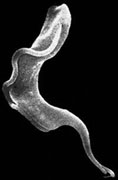 |
 |
|
 |
 |
 |
 |
 |
|
 |
 |
 |
 |

 |
 |
 |
 |

|
 |
Return to Table of Contents
 |
|
Trypanosome
|
|
New Protein May Aid Sleeping
Sickness Research
Sixty million people in 36 countries of sub-Saharan Africa are threatened daily by a deadly parasitic disease known as African sleeping sickness. The disease is caused by organisms called trypanosomes, which are spread by the tsetse fly. African sleeping sickness affects approximately 500,000 people in sub-Saharan Africa, a quarter of whom will die this year. Because the trypanosome has an exceptional genetic strategy for evading the human immune system and resisting treatment, the current treatment for this disease is melarsoprol, an antiquated drug with terrible side effects, including death.
In the February issue (Volume 17, Issue 3) of the journal Molecular Cell, scientists in the MBL’s Josephine Bay Paul Center for Comparative Molecular Biology and Evolution report their discovery of a protein called JBP2, which will help them test their hypothesis that a uniquely modified DNA base called base J is a key component of the trypanosome’s mechanism for evading the immune system. If the hypothesis is correct, it will bring scientists closer to developing a more effective drug for treating African sleeping sickness.
The trypanosome evades the human immune system because it is coated with a surface antigen called variant surface glycoprotein (VSG). The human body makes antibodies for VSG, but trypanosomes randomly switch to another antigen when the organisms divide and reproduce. Trypanosomes whose VSG has switched evade the antibodies the human immune system made to fight the original antigen, thus assuring the long-term survival of these parasites within their hosts. The trypanosome has approximately 1,000 different VSG genes, but only expresses one at a time while the others are somehow silenced. This genetic trick, called antigenic variation, has severely limited sleeping sickness treatment options and essentially ruled out the possibility of a vaccine.
MBL trypanosome experts in Robert Sabatini’s lab hypothesize that base J (beta-D-glucosylhydroxymethyluracil) may play an important role in the gene silencing process behind antigenic variation. With the goal of learning how the organism regulates the process of antigenic variation, the scientists have been trying to understand how the trypanosome makes base J.
The discovery of JBP2, a member of a protein family that helps control DNA-related functions, is a significant breakthrough in this quest because Sabatini and his colleagues were able to demonstrate that the protein is the key regulator of base J
synthesis. This will provide the scientists a new tool to elucidate the biological function of this unique modified DNA base in the regulation of antigenic variation.
If base J does indeed play a role in the gene silencing that enables the trypanosome to change its antigen coating, the discovery of JBP2 may one day enable scientists to create a drug that prevents the manufacture of base J, affecting the trypanosome’s ability to vary its antigenic coating, and therefore allowing the human immune system to kill it.
Understanding trypanosomes at the molecular level is key to fighting African sleeping sickness and diseases caused by similar parasites.
|
|
| |
 |
|
 |
 |
|